California Regulator Includes Electrification in $1 Billion Efficiency Fund, Marks Transition Away From Gas

The California Public Utilities Commission on Aug. 1 revised a 1992 energy efficiency policy to allow funding for electrification efforts, paving the way for new programs that use electric technologies powered by emissions-free resources.
The decision modifies the “three-prong test” that was originally adopted to avoid encouraging programs that involved substituting one fuel for another, such as electricity for natural gas. The agency clarified the formulation of the test, with regard to demonstrating energy savings and emissions reductions. The decision determines that fuel substitution must be measured in the same way as measures in the energy efficiency portfolio.
The revision stems from a request by environmental groups, including Natural Resources Defense Council, Sierra Club, and the California Efficiency and Demand Management Council, for a review and modification of the test, given the state’s growing focus on the potential for fuel substitution to address emissions reduction goals.
California has a goal to cut greenhouse gas emissions to 1990 levels by 2020 and 80 percent below 1990 levels by 2050. The state enacted legislation last year setting a goal of procuring 100 percent of its electricity from renewable and zero-carbon resources by 2045, and strengthening the Renewable Portfolio Standard to 60 percent by 2030, up from the previous 50 percent.
EnerKnol Pulses like this one are powered by the EnerKnol Platform—the first comprehensive database for real-time energy policy tracking. Sign up for a free trial below for access to key regulatory data and deep industry insights across the energy spectrum.
ACCESS FREE TRIAL